Outdoor Research Echo Hoodie

Outdoor Research’s Echo Hoodie is an ideal alternative to the grease and chemicals of sunscreen. Weighing in at 4 ounces, the Echo Hoodie provides SPF15 sun protection, with material that wicks sweat and keeps you comfortable when the sun is beating down on you. This hoodie and a ball cap completely negated my need to carry sunscreen (and bug spray) over the summer.
Pros
- Sun protection
- Wicks sweat
- Limited odor control
- Lightweight
- Thin material
- Packs small
- Sufficient length in torso and sleeves
- Flat stitching
Cons
- Durability
- Polyester
- THIN material
- Hot in the shade
- Pocketless
The Echo Hoodie became my go-to shirt for all outdoor activities this summer. I hiked in it—a lot. I ran in it. I rappelled into a cave in it. I mowed my yard and took a follow up nap on my deck in it. I even wore it on a winery tour for style and sun protection.



Initial Impressions
Right out of the package, I was surprised by how light and thin the hoodie was. The shirt packed down to the size of a softball in my hand and only weighed 4 ounces.
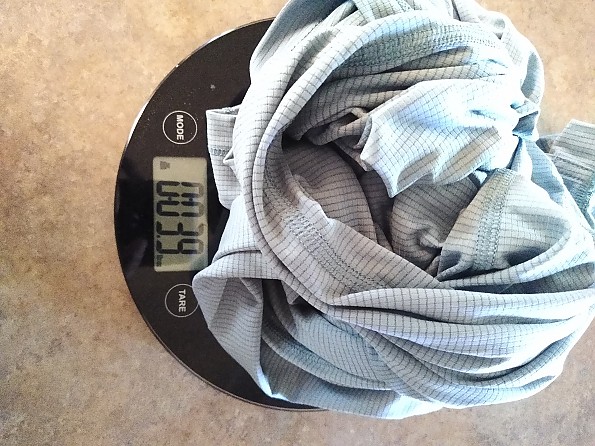
The fit was just right. I’m a tall, lanky man, with long monkey arms. However, the torso on this size medium hoodie easily reached below the hip belt of a backpack, and the sleeves’ thumb holes comfortably fit my hand. The hoodie is an athletic fit. Outdoor Research describes it as "Trim Fit, close-cut apparel that moves with the wearer."
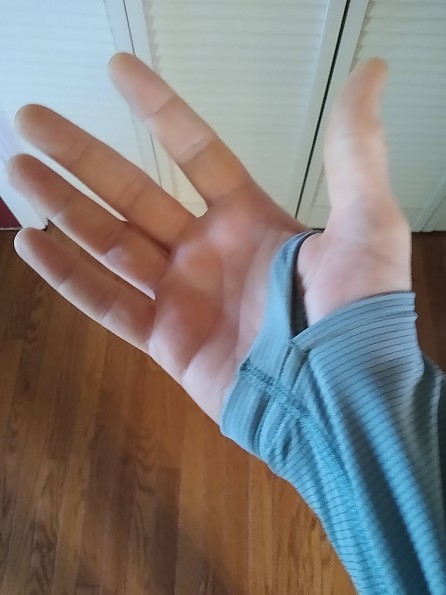
A long-sleeved summer shirt is a tough sell, and OR makes this shirt as thin as possible. That translates to “sheer.” When I first put the shirt on, my wife commented she could see my chest hairs, nipples, and navel through the shirt. Since I’m not a muscle-bound hunk with 6-pack abs, I got into the habit of wearing a wicking tank-top under the hoodie while in the front country (except during runs).
Another thought was, “a shirt this thin isn’t going to last long.” More on that later.

Sun Protection
The shirt claims a SPF (Sun Protection Factor) of 15. Since I’m used to slathering on sunscreen with a SPF of 50, I thought I would do some research on SPF ratings. Each SPF rating determines how much UVB rays are blocked from reaching your skin, and therefore impact how quickly skin will sunburn. In brief, SPF blocks 93 percent of UVB photons from reaching the skin. This translates to avoiding sunburn 15 times longer. So if a fair-skinned Irishman like me will burn in 20 minutes time, SPF 15 will extend that time to 300 minutes (5 hours).
So essentially, the hoodie was all I needed during the day here in the Midwest (Illinois, Indiana, Missouri, Tennessee), with peak sun times lasting 4 hours (10 a.m.-2 p.m.). Desert or higher altitude hikes would probably impact this.
And there is a huge caveat here. Sunscreen has to be reapplied every 2 hours (more when swimming). Once the shirt is on, there is no reapplication on the trail.
The sun protection proved itself to me many times. On July 13, I went out for a 30-minute, midday run in 80-degree heat in full sunlight. I was hot, sweaty, and unburnt. The next day, I did the same run in a tank-top and finished with sunburnt shoulders.

Later that month, I did a wine tour with friends. I was the only one in the group without sunburnt arms.

Moisture Wicking
With its 100 percent polyester material, the hoodie wicks moisture away from the body as well as expected with any performance tech shirt. It dries quickly. There is some odor control. OR has trademarked the name "ActiveFresh," which is an antimicrobial technology tied to the company HeiQ. In any case, a person running, hiking, and even mowing is going to stink regardless of the material.
- A sidebar on polyester clothing: while it is still one of the most popular materials for outdoor wear, recently I have been reading up on the environmental negatives of polyester, a petroleum-based material (for more info, check out this article from Outside Magazine).

Sun Protection vs Cooling
A few weeks ago, I reviewed cooling sleeves, which did just that—cool you. The Echo Hoodie is a sun shirt, not a cooling shirt. Exposed to the hot sun, this shirt definitely made me feel cooler. However, in heavily shaded areas, the shirt often felt it was holding heat in. In fact, on cool evenings, the hoodie was an ideal light layer to keep off the chill. This is not a con to the shirt. The hoodie does what it is designed to do.
Outdoor Research does have a line of cooling products called ActiveIce. Also, OR's Echo line of sun protection tops includes men and women's apparel in a tank, singlet (women's only), short-sleeve tee, long-sleeve tee, and quarter zip.

Bug Protection
While not advertised as a bug shirt, I had a particularly unpleasant hike, where the gnats were thick and buzzing my neck and ears. Throwing the hoodie up stopped the torture and made the hike much more pleasant. Treating the shirt in Permethrin adds protection from ticks and mosquitoes.

Durability
I normally select one older t-shirt to wear throughout the spring/summer/fall hiking season and wear it out until it’s ready for the trash. From the get-go I didn’t expect this thin shirt to last the summer. While it is showing plenty of wear, the shirt has not developed any holes yet. I’ve not babied it in any way. I’ve bushwhacked in it, worn it under a chest harness, and regularly thrown it in the washing machine with my other clothing. So while I don’t consider this shirt to have a long lifespan, it does give you a hiking season of solid use. When it eventually wears out, I am guessing it will be under the shoulder straps of my pack.
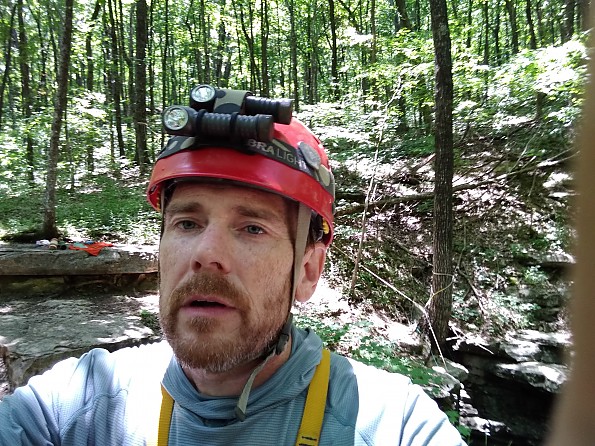
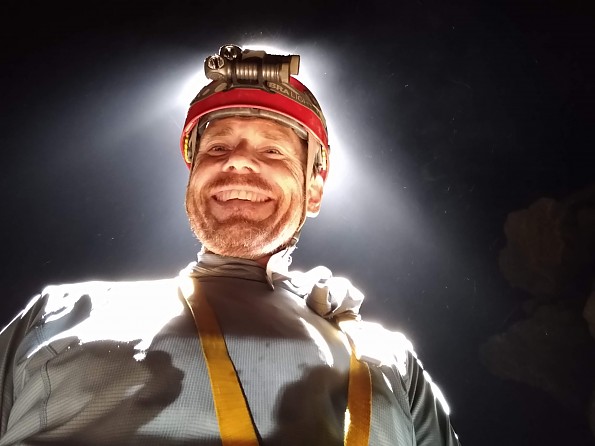
sun shining down on me from the entrance.
Summation
This hoodie has given a summer of solid performance and lives up to its manufacturer’s claims. It is more versatile than sunscreen, and at 4 ounces, weighs less than a tube of lotion in your backpack. While $65 is pricey for a long-sleeved, hooded t-shirt, I anticipate eventually getting a full 100+ days of activity from this shirt (hiking, running, mowing, etc). That comes to a cost of $0.65 per day. That’s not a bad deal in the long run.
Background
I am a fair-skinned person prone to sunburning. I wore the shirt throughout June, July, and August 2020 in different outdoor settings, and experienced no burning while in the shirt.
Source: received for testing via the Trailspace Review Corps
(Sample for testing and review provided by Outdoor Research)
The very best long sleeve base layer out of many I've tried!
Pros
- Breathes extremely well
- Dries quickly
- Has a hood!
- Uber lightweight
Cons
- The older style had a funky "mitten" setup, the new one uses just a regular thumbhole—much improved!
I've meant to review this earlier as I have three full seasons using this shirt (actually now own three). I use this base layer summer through winter. It cheats all the important criteria of a base layer—lightweight, check; breathes well, check; dries quickly, check; AND has a hood. I use the hood all the time, in the summer to shade my neck/sides of my face and when cool to add a little warmth on the move.
It utilizes a synthetic microgrid fabric that is gossamer light and feels good next to the body. The hood is well designed and fits perfectly. The only con, which has now been rectified by OR was the older style utilized some kind of funky "mitten" affair in lieu of a simple thumbhole—it simply didn't work. With the thumbhole, it does :)
I generally use a light colored one in the summer, darker one in the winter. It probably would be worth OR's time to release one in pure white for summer use.
I'm guessing I have several hundred days of use with this shirt (actually three now) and I can't say enough good about it. It's bar none the best layer shirt I've owned (and I've owned a ton). The fabric for being so light is amazingly tough, out of hundreds of days of use, I might have two or three small snags—and that's with extensive off-trail travel.
Buy it, you'll like it.

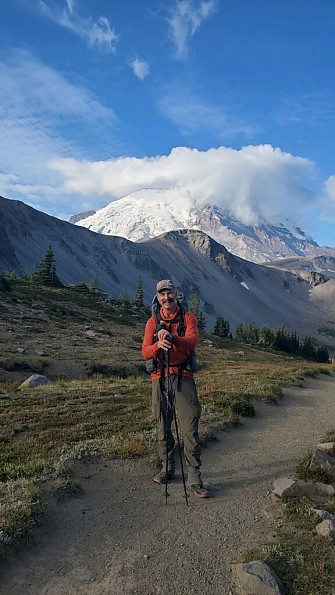
Background
Roughly three seasons (year round) and hundreds of days/nights of use.
Source: bought it new
Price Paid: $45
Your Review
Where to Buy
You May Like
Specs
| Men's | |
|---|---|
| Price |
MSRP: $65.00 Current Retail: $44.97-$75.00 Historic Range: $26.00-$75.00 Reviewers Paid: $45.00 |
| Weight |
4.3 oz / 122 g |
| Fit |
Trim Fit |
| Center Back Length |
29 in / 74 cm |
| Fabric |
Airvent 100% polyester |
| Women's | |
|---|---|
| Price |
MSRP: $65.00 Current Retail: $17.24-$75.00 Historic Range: $13.79-$75.00 |
| Weight |
2.3 oz / 64 g |
| Fit |
Trim Fit |
| Center Back Length |
27.5 in / 70 cm |
| Fabric |
Airvent 100% polyester |

